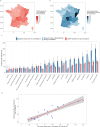Computerised decision support system towards informing Lyme borreliosis incidence in France
- PMID: 40319191
- PMCID: PMC12049454
- DOI: 10.1038/s41598-025-99896-8
Computerised decision support system towards informing Lyme borreliosis incidence in France
Abstract
In Europe, the estimation of Lyme borreliosis (LB) incidence is challenged by its heterogeneous reporting. In France, LB incidence is estimated from cases reported voluntarily to the Sentinelles network through general practitioners (GPs). Here, we explored how a computerised decision support system (CDSS), Antibioclic, with higher GPs participation and country-wide coverage, can inform further LB incidence. We derived the incidence of LB Antibioclic indicators (with either erythema migrans or disseminated disease), surveyed Antibioclic usage for suspect cases seen in GP consultations, and compared those estimates with the Sentinelles network estimations. In 2023, the incidence of Antibioclic LB indicators (290 per 100,000 inhabitants; CI95%, 277-303) was almost five times higher than LB incidence from the Sentinelles network, but sharing similar higher-incidence regions. Antibioclic LB indicators under-estimated the incidence of suspect cases seen in higher-incidence regions, while in lower-risk regions, Antibioclic estimation was closer to observed suspect cases. Refine estimates would benefit from improved follow up over time and space while improving case definition.
Keywords: Computerised decision support system (CDSS); Incidence estimation; Lyme borreliosis; Spatial analysis.
© 2025. The Author(s).
Conflict of interest statement
Declarations. Competing interests: Raphaëlle Métras is an Editorial Board Member in a nature portfolio journal (Communications Medicine). All other authors declare no financial or non-financial competing interests.
Figures





Similar articles
-
Epidemiology of Lyme borreliosis through two surveillance systems: the national Sentinelles GP network and the national hospital discharge database, France, 2005 to 2016.Euro Surveill. 2019 Mar;24(11):1800134. doi: 10.2807/1560-7917.ES.2019.24.11.1800134. Euro Surveill. 2019. PMID: 30892181 Free PMC article.
-
Prevalence and factors associated with a prescription of a Lyme borreliosis serology for erythema migrans diagnosis in general practice: a study from the French sentinel network, 2009-2020.BMC Prim Care. 2023 Aug 24;24(1):163. doi: 10.1186/s12875-023-02108-3. BMC Prim Care. 2023. PMID: 37620763 Free PMC article.
-
Skin Changes in Suspected Lyme Disease.Acta Dermatovenerol Croat. 2023 Dec;31(4):225-228. Acta Dermatovenerol Croat. 2023. PMID: 38651851
-
Lyme borreliosis and other tick-borne diseases. Guidelines from the French Scientific Societies (I): prevention, epidemiology, diagnosis.Med Mal Infect. 2019 Aug;49(5):318-334. doi: 10.1016/j.medmal.2019.04.381. Epub 2019 May 13. Med Mal Infect. 2019. PMID: 31097370 Review.
-
Combining primary care surveillance and a meta-analysis to estimate the incidence of the clinical manifestations of Lyme borreliosis in Belgium, 2015-2017.Ticks Tick Borne Dis. 2019 Apr;10(3):598-605. doi: 10.1016/j.ttbdis.2018.12.007. Epub 2018 Dec 28. Ticks Tick Borne Dis. 2019. PMID: 30772196
References
MeSH terms
Grants and funding
LinkOut - more resources
Full Text Sources
Medical

